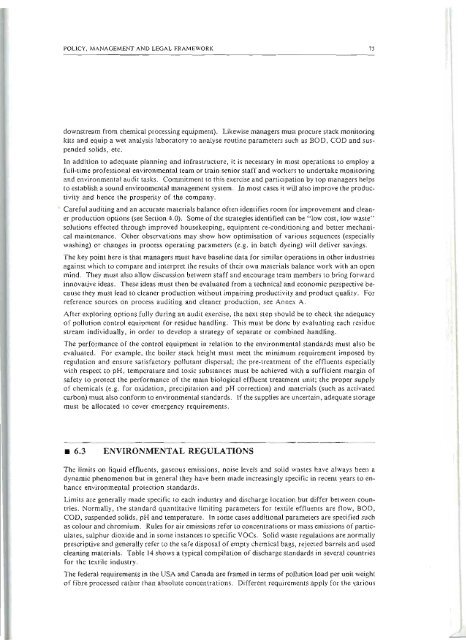Contributor, The Textile Industry and the Environment, UNEP
Contributor, The Textile Industry and the Environment, UNEP
Contributor, The Textile Industry and the Environment, UNEP
Create successful ePaper yourself
Turn your PDF publications into a flip-book with our unique Google optimized e-Paper software.
POLlCY, MANAGEMENT AND LEGAL FRAMEWORK 73<br />
downstream from chemical processing equipment). Likewise managers must procure stack monitoring<br />
kits <strong>and</strong> equip a wet analysis laboratory 10 analyse routine parameters such as BOD, COD <strong>and</strong> suspended<br />
solids, etc.<br />
In addition to adequate planning <strong>and</strong> infrastructure, it is necessary in most operations to employ a<br />
full-time professional environmental team or train senior staff <strong>and</strong> workers to undertake monitoring<br />
<strong>and</strong> environmental audit tasks. Commitment to this exercise <strong>and</strong> participation by top managers helps<br />
to establish a sound environmental management system. In most cases it will also improve <strong>the</strong> productivity<br />
<strong>and</strong> hence <strong>the</strong> prosperity of <strong>the</strong> company.<br />
Careful auditing <strong>and</strong> an accurate materials balance often identifies room for improvement <strong>and</strong> cleaner<br />
production options (see Section 4.0). Some of <strong>the</strong> strategies identified can be "low cost, low waste"<br />
solutions effected through improved housekeeping, equipment re-conditioning <strong>and</strong> better mechanical<br />
maintenance. O<strong>the</strong>r observations may show how optimisation of various sequences (especially<br />
washing) or changes in process operating parameters (e.g. in batch dyeing) will deliver savings.<br />
<strong>The</strong> key point here is that managers must have baseline data for similar operations in o<strong>the</strong>r industries<br />
against which to compare <strong>and</strong> interpret <strong>the</strong> results of <strong>the</strong>ir own materials balance work with an open<br />
mind. <strong>The</strong>y must also allow discussion between staff <strong>and</strong> encourage team members to bring forward<br />
innovative ideas. <strong>The</strong>se ideas must <strong>the</strong>n be evaluated from a technical <strong>and</strong> economic perspective because<br />
<strong>the</strong>y mUSt lead to cleaner production without impairing productivity <strong>and</strong> product quality. For<br />
reference sources on process auditing <strong>and</strong> cleaner production, see Annex A.<br />
After exploring options fully during an audit exercise, <strong>the</strong> next step should be to check <strong>the</strong> adequacy<br />
of pollution control equipment for residue h<strong>and</strong>ling. This must be done by evaluating each residue<br />
stream individually, in order to develop a strategy of separate or combined h<strong>and</strong>ling.<br />
<strong>The</strong> performance of <strong>the</strong> control equipment in relation to <strong>the</strong> environmental st<strong>and</strong>ards must also be<br />
evaluated. For example, <strong>the</strong> boiler stack height mllst meet <strong>the</strong> minimum requirement imposed by<br />
regulation <strong>and</strong> ensure satisfactory pollutant dispersal; <strong>the</strong> pre-treatment of <strong>the</strong> effluents especially<br />
with respect to pH, temperature <strong>and</strong> toxic substances must be achieved with a sufficient margin of<br />
safety to protect <strong>the</strong> performance of <strong>the</strong> main biological effluent treatment unit; <strong>the</strong> proper supply<br />
of chemicals (e.g. for oxidation, precipitation <strong>and</strong> pH correction) <strong>and</strong> materials (such as activated<br />
carbon) must also conform to environmental st<strong>and</strong>ards. If <strong>the</strong> supplies are uncertain, adequate storage<br />
must be allocated to cover emergency requirements.<br />
• 6.3 ENVIRONMENTAL REGULATIONS<br />
<strong>The</strong> limits on liquid effluents, gaseous emissions, noise levels <strong>and</strong> solid wastes have always been a<br />
dynamic phenomenon but in general <strong>the</strong>y have been made increasingly specific in recent years to enhance<br />
environmental protection st<strong>and</strong>ards.<br />
Limits are generally made specific to each industry <strong>and</strong> discharge location but differ bet ween countries.<br />
Normally, <strong>the</strong> st<strong>and</strong>ard quantitative limiting parameters for textile effluents are flow, BOD,<br />
COD, suspended solids, pH <strong>and</strong> temperature. In some cases additional parameters are specified such<br />
as colour <strong>and</strong> chromium. Rules for air emissions refer to concentrations or mass emissions of particulates,<br />
sulphur dioxide <strong>and</strong> in some instances to specific VOCs. Solid waste regulations a("e normally<br />
prescriptive <strong>and</strong> generally refer to <strong>the</strong> safe disposal of empty chemical bags, rejected barrels <strong>and</strong> used<br />
cleaning materials. Table 14 shows a typical compilation of discharge st<strong>and</strong>ards in several countries<br />
for <strong>the</strong> textile industry.<br />
<strong>The</strong> federal requirements in <strong>the</strong> USA <strong>and</strong> Canada are framed in terms of pollution load per unit weight<br />
of fibre processed ra<strong>the</strong>r than absolute concentrations. Different requirements apply for <strong>the</strong> '{arious

















